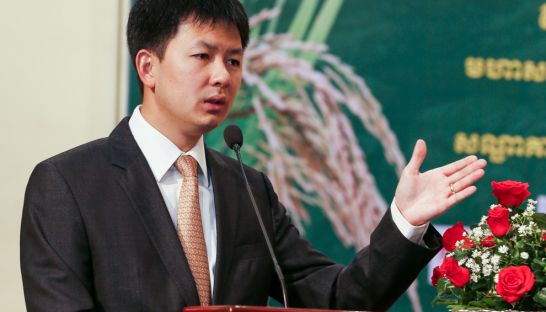Report calls for action to keep rice sector afloat
Report calls for action to keep rice sector afloat
A group of rice millers and exporters critical of the direction in which the rice industry is being steered submitted a detailed report to the Commerce Ministry yesterday, warning that local producers were being driven to bankruptcy and calling for immediate action, such as a quota on rice imports and debt rescheduling for millers, to alleviate the sector’s woes.
The report expands on a presentation made during a meeting last week between the group, whose initiative is called Rice Industry Strategic Key Solution (RISKS), and Commerce Minister Sun Chanthol, in which its members outlined the rice sector’s deteriorating conditions and cast blame in part on the ineffectual governance of the Cambodian Rice Federation (CRF).
Following the presentation, Chanthol requested a more detailed report on the situation and recommendations, which he said would be forwarded to Prime Minister Hun Sen.
Of the suggested action, the group prioritised the imposition of a quota on the import of milled rice from Vietnam, which they say makes local millers less competitive, as well as working with commercial banks and microfinance institutions to delay millers’ debt payments.
“According to estimates, around 700,000 tonnes to 800,000 tonnes of milled rice was imported from Vietnam in 2015,” the report reads. “These imports from Vietnam have ‘taken over and invaded’ the local rice market.”
The RISKS group, which has grown from 18 members last week to 24 now, claims that the flood of milled rice imports from Vietnam has driven 40 per cent of Cambodian millers out of business in the last three years.
The proposed rice quota, the group says, would limit foreign imports to 100,000 tonnes a year and add a 35 per cent tax to the invoiced price of the imported rice. It said similar measures have been implemented in other countries such as Thailand, Malaysia and Indonesia.
“We have a lot of our own potential for rice export, so there is a case for a quota limiting the import of rice” said Kann Kunthy, CEO of Battambang rice miller Brico. “We have already studied this suggestion and it will have no issues with WTO regulations.”
Kunthy said the group’s nine-point solution needed to be addressed in the next three months if the government wanted millers to reach its ambitious one-million-tonne per year milled rice export target.
“We have done 50 per cent of the work by finding solutions and the government has to help complete the remaining 50 per cent by implementation,” he said, adding the CRF has failed to address the industry’s troubles since it was formed two years ago.
Softening its initial demand, the RISKS group urged the government to help millers obtain $250 million in soft loans at 4 per cent interest per annum, while pushing back their loan obligations.
“We suggest that banks and microfinance institutions reschedule the loan payments for rice millers in order to give them a chance for survival,” said Song Saran, CEO of Amru Rice and a member of the RISKS initiative.
Other solutions listed in the report include stricter enforcement of punitive action for millers found mixing local and imported rice, reducing the cost of electricity for millers and elimination of the value-added tax (VAT) for millers.
In response to the group’s first meeting with the Commerce Ministry, the CRF issued a press release last week stating that it was looking at three key issues – rice imports from neighbouring countries, shortage of financing options for millers and high electricity costs.
“The CRF is trying their best to work with relevant stakeholders to seek solutions for the rice sector and requests that all members join us and find a solution together,” said CRF president Sok Puthyvuth.














